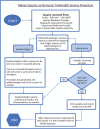Rabies experts on demand: A cross-sectional study describing the use of a rabies telehealth service
- PMID: 38192571
- PMCID: PMC10772938
- DOI: 10.1002/puh2.109
Rabies experts on demand: A cross-sectional study describing the use of a rabies telehealth service
Abstract
Background: Rabies expert on demand (REOD) telehealth service is provided by the U.S. Centers for Disease Control and Prevention (CDC) to assist public health practitioners, health providers, and the public to interpret national and international rabies prevention guidelines. REOD is staffed by subject matter experts of the CDC Poxvirus and Rabies Branch to assess each unique situation and provide evidence-based guidance to stakeholders. This study aims to describe the utilization of a rabies telehealth system and provide insight into common consultations.
Methods: A cross-sectional study of the nature of inquiries to REOD was done using the data collected from September 1, 2017 to September 30, 2021. An inquiry tracking form and Microsoft Access database were developed to document all inquiries received. Inquired ones were summarized to determine the frequency of inquiries by month, category, and location.
Results: Over a 49-month period, REOD received 5228 inquiries. Peak inquiries (n = 108) occurred during August 2019. The most frequent inquiries received pertained to risk assessment and management of rabies exposures (n = 1109), requests for testing assistance (n = 912), consultation for suspected human rabies (n = 746), rabies exposures and post-bite treatment occurring internationally (n = 310), and consultation for deviations in the recommended pre- and postexposure prophylaxis regimen (n = 300).
Conclusion: REOD is a global resource for consultation related to managing rabies exposures, diagnostic issues, and rabies control strategies. REOD is a regularly utilized CDC service, as the demand for up-to-date rabies guidance remains high. REOD fulfills a critical role for the interpretation and consultation on rabies prevention guidelines to stakeholder.
Keywords: digital health; prevention and control; public health; rabies; telehealth service; telemedicine; zoonotic disease.
Conflict of interest statement
CONFLICT OF INTEREST STATEMENT The authors declare that there are no conflicts of interest that could be perceived as prejudicing the impartially of the research reported.
Figures



References
-
- Ma X, Bonaparte S, Toro M, et al. Rabies surveillance in the United States during 2020. J Am Vet Med Assoc. 2022;260(10):1157‐1165. - PubMed
-
- Grace D, Mutua F, Ochungo P, et al. Mapping of Poverty and Likely Zoonoses Hotspots. International Livestock Research Institute; 2012.
-
- Rysava K, Espineda J, Silo EA, et al. One health surveillance for rabies: a case study of integrated bite case management in Albay province, Philippines. Front Trop Dis. 2022;3:787524.
-
- One Health and Disease: Rabies (U.S. National Park Service) [Internet]. 2018. [Cited 2021 Dec 17] www.nps.gov Available from: https://www.nps.gov/articles/one‐health‐disease‐rabies.htm
-
- Manning SE, Rupprecht CE, Fishbein D, et al. Human rabies prevention—United States, 2008: recommendations of the advisory committee on immunization practices. MMWR Recomm Rep. 2008;57(RR‐3):1‐28. - PubMed
Grants and funding
LinkOut - more resources
Full Text Sources
